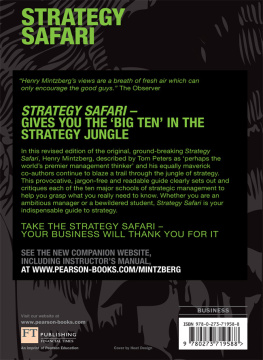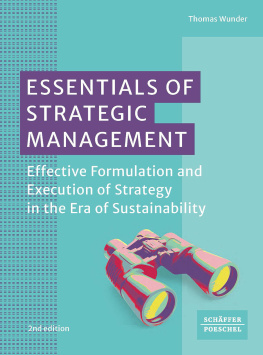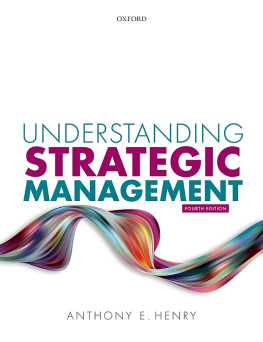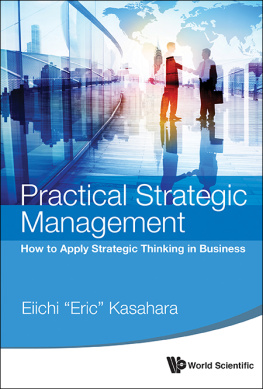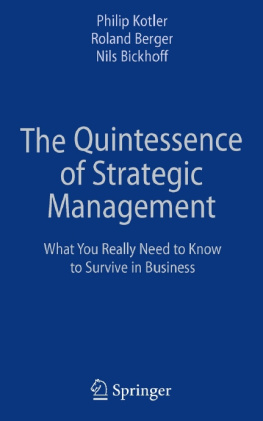Strategy Safari
Strategy Safari
The complete guide through the wilds of strategic management
Henry Mintzberg
Bruce Ahlstrand
Joseph Lampel
Second Edition

PEARSON EDUCATION LIMITED
Edinburgh Gate
Harlow CM20 2JE
United Kingdom
Tel: +44 (0)1279 623623
Fax: +44 (0)1279 431059
Website: www.pearsoned.co.uk
First edition published in the United States of America
by The Free Press, a Division of Simon & Schuster, Inc
First edition published in Great Britain in 1998
Second edition published in Great Britain in 2009
Henry Mintzberg, Bruce Ahlstrand and Joseph Lampel 1998, 2009
The rights of Henry Mintzberg, Bruce Ahlstrand and Joseph Lampel to be identified as authors of this work has been asserted by them in accordance with the Copyright, Designs and Patents Act 1988.
All rights reserved; no part of this publication may be reproduced, stored in a retrieval system, or transmitted in any form or by any means, electronic, mechanical, photocopying, recording, or otherwise without either the prior written permission of the Publishers or a licence permitting restricted copying in the United Kingdom issued by the Copyright Licensing Agency Ltd, Saffron House, 6-10 Kirby Street, London EC1N 8TS. This book may not be lent, resold, hired out or otherwise disposed of by way of trade in any form of binding or cover other than that in which it is published, without the prior consent of the Publishers.
ISBN: 978-0-273-71958-8
British Library Cataloguing in Publication Data
A CIP catalogue record for this book can be obtained from the British Library
Library of Congress Cataloging in Publication Data
Mintzberg, Henry.
Strategy safari : the complete guide through the wilds of strategic management/Henry Mintzberg, Bruce Ahlstrand, Joseph Lampel. -- 2nd ed.
p. cm.
Includes bibliographical references and index.
ISBN 978-0-273-71958-8 (pbk.)
1. Strategic planning. 2. Business planning. I. Ahlstrand, Bruce W. II. Lampel, Joseph. III. Title.
HD30.28.M564 2009
658.4'012--dc22
2008034094
10 9 8 7 6 5 4 3 2 1
12 11 10 09 08
Set by 30
Printed and bound in Great Britain by Ashford Colour Press Ltd, Gosport, Hants
The Publisher's policy is to use paper manufactured from sustainable forests.
Dedication
There are some people who begin the Zoo at the
beginning, called WAYIN, and walk as quickly as
they can past every cage until they come to the one
called WAYOUT, but the nicest people go straight to
the animal they love the most, and stay there.
A.A. Milne, in the Introduction to Winnie-The-Pooh
We dedicate this book to such people who are more interested in open fields than closed cages.
Contents
Publisher's acknowledgements
We are grateful to the following for permission to reproduce copyright material:
was published in Organizational Dynamics , Vol. 20, Richard W. Beatty and David O. Ulrich, "Re-energizing the mature organization", 1 page only, Copyright Elsevier (1991)
We are grateful to the following for permission to reproduce the following texts:
Reserved; "Gentlemen, let us pool..." The New Yorker Collection 1975 Stan Hunt from cartoonbank.com. All Rights Reserved; "What I especially like." ScienceCartoonPlus.com; "Send in two eggs... " P.C Vey; "Before we talk about direction." Cartoon by permission of Mark Litzler; "Miss Denby, bring in my rose-colored glasses." 2008 Robert Mankoff from cartoonbank.com. All Rights Reserved; "I didn't think it would be so." ScienceCartoonPlus.com; "They can't find their hidden agenda" 2008 by Nick Downes; "No wonder he never forgets." ScienceCartoonPlus.com; "Because I've already said." The New Yorker Collection 1995 Mort Gerberg from cartoonbank.com. All Rights Reserved; "Is that it?" ScienceCartoonPlus.com
In some instances we have been unable to trace the owners of copyright material, and we would appreciate any information that would enable us to do so.
Embarkation
This trip began with a paper by Henry called "Strategy Formation: Schools of Thought" published by Jim Fredrickson in a collection entitled Perspectives on Strategic Management. Bruce used the paper in a course at Trent University and found that it worked well. "Why don't you do a book on it?" he suggested. "Why don't we do it together?" Henry replied. They both thought that Joe would make an excellent member of the team. So the safari got underway.
We did not, however, write this as a textbook or some sort of academic treatise. From the outset, we believed that the book should have as much relevance for managers and consultants in practice as students and professors in the classroom. So we set out to write an easily accessible explanation of the fascinating field of strategic management. Sure, some parts are tougher than others; this is in the nature of the beast. We have not set out to domesticate it, but to make it friendly. We want readers from everywhere to join our safari, but at the same time we want to challenge them. As we argue throughout, the field of strategic management needs to be opened up, not closed down; it needs reconciliation among its many different tendencies, not the isolation of each.
To enrich the experience of this safari, we have also published Strategy Bites Back, a companion book with a similar structure and more playful content. We have also prepared an Instructor's Manual to facilitate the use of the rather unconventional nature of Strategy Safari in the classroom.
We owe many thank-yous. For the first edition, Bob Wallace of The Free Press must be especially singled out. Abby Luthin gave welcome support there as well. Kate Maguire provided great help. (Kate labeled the manuscript "The Beast" long before it received its current title.) She was supported admirably by Elana Trager, especially in tracking down some tricky bits of information. Coralie Clement dealt with all the references and permissions, plus lots more, working across countries, authors, and problems with remarkable skill. At one point, she wrote in an e-mail, "I think it's pretty awesome that I am communicating with a Franco-Anglo-Canadian in India about a book being published in the U.S. and Europe . Ahhh, modern life."
Particularly wise and helpful in the first edition were comments on the manuscript provided by Jolle Meric. Thanks also go to the doctoral students of Henry's colloquium in Montreal, who made a number of helpful suggestions.
The second edition is a re-embarkation: We went back and looked again at what we wrote, clarifying some parts, and adding where new ideas have emerged. Many people had a hand in making this reembarkation possible. We would like to thank all the readers who over the years kept sending us comments and ideas: the students who forced us to rethink this or that part of the book; and the instructors who elected to use the book, often in surprising and innovative fashion. Our particular thanks go to Liz Gooster, Richard Stagg, Ajay Bhalla, Shiva Nadavulakere, Melissa Nadler and Santa Balanca- Rodrigues, with special appreciation to Pushkar Jha for his help.
The new edition contains numerous minor changes and some major additions. We added new sections on topics as varied as dynamic capabilities, the relationship between cognition and competition, real options theory, the impact of top and middle-management on strategic decision making, and the "strategy-as-practice" movement.

